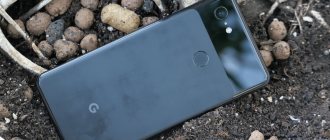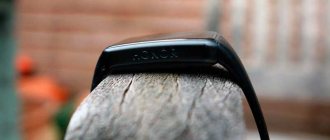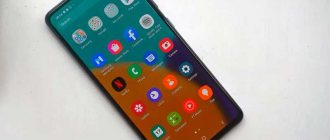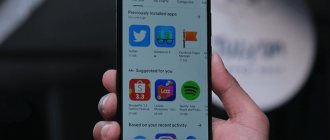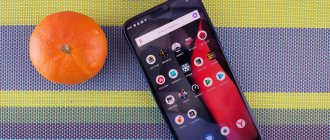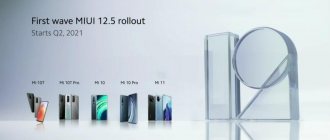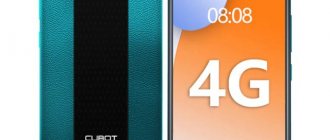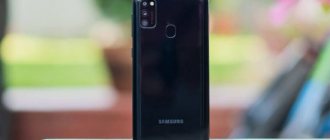Google's Nexus smartphones have been replaced by the Pixel series with a very stylish design, top-end hardware and a powerful camera. The Google Pixel 2 has a standard 5-inch display, while the Google Pixel 2 XL has a 6-inch 18:9 curved display.
Design of updated smartphones
The original Pixel stood out thanks to its two-tone back panel with a glass top and metal bottom. New smartphones from Google also use different materials, but the glass is not so pronounced and only covers the upper area where the cameras are.
The aluminum body of the Google Pixel 2 and Google Pixel 2 XL has a hybrid coating that looks like plastic but feels like ceramic. The brushed metal contrasts interestingly with the glossy glass of the display.
At the top there is a microphone hole, on the left side there is a SIM card tray, at the bottom there is another microphone and a USB Type-C port. Analog jack 3.5 mm. There is no headphone connection. On the right side you will find the power button, below it is the volume rocker. This arrangement causes confusion; usually the volume key is located higher.
The IP67 rating means that the new Google smartphones are completely resistant to dust and will survive short-term immersion in water. Although some of their competitors boast IP68 protection.
The Google Pixel 2 has wider top and bottom bezels than the Pixel 2 XL, but both smartphones accommodate front-facing stereo speakers.
Thanks to the curved design, the Google Pixel 2 XL has much thinner edges, although the overall thickness is the same. Pixel 2 is smaller in width, making it easier to hold in your hand. Another difference is that on the XL, the “G” logo on the back is shiny and reflects light.
Google Pixel 2 Size Comparison Chart
| Smartphone | Dimensions (mm.) | Weight (g) |
| Google Pixel 2 | 145.7? 69.7? 7.8 mm. | 143 gr. |
| Google Pixel | 143.84? 69.54? 8.58 mm. | 143 gr. |
| Samsung Galaxy S8 | 148.9? 68.1? 8.0 mm. | 152 gr. |
| Apple iPhone 8 | 138.4? 67.3? 7.3 mm. | 148 gr. |
Google Pixel 2 XL size comparison table
| Smartphone | Dimensions (mm.) | Weight (g) |
| Google Pixel 2 XL | 157.9? 76.7? 7.9 mm. | 175 gr. |
| Google Pixel XL | 154.72? 75.74? 8.6 mm. | 168 gr. |
| Samsung Galaxy S8+ | 159.5? 73.4? 8.1 mm. | 173 gr. |
| Apple iPhone 8 Plus | 158.4? 78.1? 7.5 mm. | 202 gr. |
Detailed technical specifications
Make and model
Make and model of the device, and alternative names (if any).
| Brand Device manufacturer company. | |
| Model Device name. | Pixel 2 |
| Alternative names Other model names, if available. Sometimes the model is called differently, depending on the country or because of popular nicknames. | Pixel2 |
Design
Appearance of the device including dimensions, weight, volume, colors and materials.
| Width The horizontal side of the device when used in standard orientation. | 69.7 mm (millimeters) |
| Height The vertical side of the device when used in standard orientation. | 145.7 mm (millimeters) |
| Thickness The cross-sectional size of the device. | 7.8 mm (millimeters) |
| Weight How much does the device weigh excluding the case, SIM and memory cards and other additional elements. | 143 g (grams) |
| Volume Approximate value calculated using the formula: length times width times height. | 79.21 cm³ (cubic centimeters) |
| Colors What colors is the device available in? | Black White Blue |
| Housing materials What materials is the body made of? | Aluminium alloy |
System on a Chip (SoC)
A system on a chip, a single-chip system (System on a Chip, SoC) is when several systems performing different device functions are connected on one chip.
| System on a Chip (SoC) A single-chip system that contains components such as a processor, graphics accelerator, memory units, communication interfaces, etc., as well as software for the operation of the system. | Qualcomm Snapdragon 835 MSM8998 |
Central processing unit (CPU)
| Central processing unit (CPU) The main component of the device is responsible for calculations and data processing. | 4x 2.35 GHz Kryo 280, 4x 1.9 GHz Kryo 280 |
| Technical process What technological process is used to make the chip? The smaller the process technology, the better - the chips consume less power and generate less heat. | 10 nm (nanometers) |
| Processor size Processor capacity is a parameter that indicates how many bits of data a processor register processes in 1 clock cycle. This is usually 32 or 64 bits. | 64 bit |
| Instruction Set Architecture Instruction set architecture (ISA) is a programmable part of the microprocessor core used by software to control the operation of the processor. | ARMv8-A |
| Number of processor cores The processor can be either single-core or multi-core. The performance of the processor depends on the number of cores (threads). The more cores working simultaneously, the higher the power consumption, so in mobile devices all cores are used only under high load. | 8 |
| CPU clock speed Clock speed is the number of operations per second that a processor or its core can achieve. The higher the frequency, the higher the overall performance of the device, but performance also depends on the processor architecture and the number of cores. | 2350 MHz (megahertz) |
Graphics Processing Unit (GPU)
| Graphics Processing Unit (GPU) The graphics processing unit (GPU) is used to process and display graphics - 3D effects, games, interfaces and other visual elements. Due to the pipeline architecture, the GPU is many times more efficient in graphics processing than the processor. | Qualcomm Adreno 540 |
| GPU clock speed Clock speed is the number of operations per second that the GPU or its core is capable of achieving. The higher the frequency, the higher the speed of the processor, and therefore the number of tasks it can solve. | 710 MHz (megahertz) |
Random access memory (RAM)
| Amount of random access memory (RAM) RAM (Random Access Memory, RAM, RAM) is temporary memory (works only while the device is running), which stores data and code for the operational operation of programs and applications. The more RAM, the more programs you can run simultaneously without loss of performance (there will be fewer “brakes”). | 4 GB (gigabytes) |
| Type of random access memory (RAM) Information about the type of RAM used by the device. | LPDDR4X |
| Number of RAM channels 1 is a single-channel RAM operating mode, basic, when 1 memory module is used. 2 is already a two-channel mode - a mode of parallel operation of 2 modules or pairs of modules, memory channels - this mode is 2 times faster than a single-channel one. 3 – three-channel mode is 3 times faster than single-channel mode. | Dual channel |
| RAM frequency The frequency of RAM determines the speed of RAM, or rather the speed of data transfer and reception. In theory, the higher the frequency, the more powerful the RAM. | 1866 MHz (megahertz) |
Built-in memory
Most mobile devices have built-in Flash memory, which is used as a storage for system data, the operating system, as well as user data - photos, videos, recordings and much more.
| Built-in memory capacity The higher the amount of built-in memory, the more games, programs, music, videos and your other files will fit in the device, especially the amount of memory is important when the device does not support memory cards. | 64 GB (gigabytes) 128 GB (gigabytes) |
Operating system
A mobile operating system (OS) is pre-installed software with a well-thought-out interface for user control of device functions.
| Operating system (OS) The operating system installed by default by the device manufacturer, as well as its version. | Android 8.0.0 Oreo Android 9.0 Pie |
Battery
To operate autonomously, a mobile device requires a battery that powers all its components.
| Battery capacity The main characteristic of a battery is its maximum capacity, that is, the charge it can store. Capacity is measured in mAh (mAh, milliamp-hour). The higher the capacity, the longer the mobile device can work. | 2700 mAh (milliamp-hours) |
| Battery type Many types of batteries have been used in portable devices, but NiCd (nickel-cadmium), NiMH (nickel-metal hydride), and even more so SLA (lead-acid) batteries are already considered obsolete. Instead, modern mobile devices use Li-Ion (lithium-ion) and Li-Pol, Li-Poly (lithium-polymer) batteries. | Li-Ion (Lithium-ion) |
| Power adapter Characteristics of the charger (adapter, power supply) included in the standard package of the mobile device. More precisely, the output voltage in volts (V) and the output current in amperes (A). | 9 V (volts) / 2 A (amps) |
| Fast charging Fast charging is when the device charges very quickly. For example, up to 50-70% of a full battery charge in ten minutes. | Yes |
Screen
The screen (display) is the main element for displaying graphic information.
| Technology The technology used to make the screen. There are many types of display manufacturing with their pros and cons. | AMOLED |
| Diagonal The screen diagonal of a device is measured in inches (inch, in or simply ″), and 1″ is equal to 2.54 cm. | 5 in (inches) 127 mm (millimeters) 12.7 cm (centimeters) |
| Width Approximate screen width | 62.26 mm (millimeters) 6.23 cm (centimeters) |
| Height Approximate screen height | 110.69 mm (millimeters) 11.07 cm (centimeters) |
| Aspect Ratio Aspect ratio is the ratio of the shorter side of the screen, which is considered to be 1, to the longer side, which is denoted by a decimal fraction indicating the ratio to the short side. | 1.778:1 16:9 |
| Screen resolution Screen resolution is the number of horizontal pixels (dots) multiplied by the number of vertical pixels. The higher the resolution, the more detailed the image will be. | 1080 x 1920 pixels |
| Pixel Density The number of pixels per inch or PPI (pixels per inch) indicates the density of pixels per 1 inch (2.54 cm) of the screen. The higher the PPI, the sharper the image, and the less visible or even invisible “squares and dots” (pixels). | 441 ppi (pixels per inch) 173 ppcm (pixels per centimeter) |
| Color depth Color depth means how many bits are used in 1 pixel to display color (bits per pixel). | 24 bit 16777216 colors |
| Screen area Approximate usable area occupied by the screen on the front of the device. The higher the percentage, the narrower the frames around the display or the smaller the “chin with bangs.” | 68.08% (percent) |
| Touch screen A touch screen is a device that usually covers the display and is a touch input tool. In fact, in mobile devices, the touchscreen is a replacement for the keyboard and mouse. | Yes |
| Touch screen type There are many types of touch screens, with their pros and cons. Mobile devices often use capacitive touchscreens, but technology does not stand still and new types of sensors are appearing. | Capacitive |
| Multi-touch Touch screen support for two or more touches. For example, zooming photos with two fingers. | Yes |
| Impact-resistant protective glass of the display The screen and touchscreen of a mobile device are usually covered with protective tempered glass (sometimes plastic or film is used instead of glass) to protect the display from impacts and scratches. Many companies are engaged in the production of such protection, but the most famous are Corning - Gorilla Glass and Asahi - Dragontrail. | Yes Corning Gorilla Glass 5 |
| 2.5D screen 2.5D is a display with rounded edges. Device manufacturers use a 2.5D screen as a design element, for a pleasant tactile sensation, or to add durability, dust and moisture protection. | Yes |
| Display Contrast Ratio Contrast ratio is the ratio of display brightness in the white area to the black area. For example, 1000:1 means that white is 1000 times brighter than black. The higher the ratio, the deeper the blacks and the overall better image. | 100000:1 |
| Additional Information Additional information about screen functions and characteristics. | Always-On Display |
Main camera
The main camera, usually built into the rear of the device, is designed for creating photo and video content.
| Maximum image resolution This is the maximum number of pixels (dots) horizontally and vertically. The higher the resolution, the more detailed the image will be. Resolution can also be indicated in megapixels - this is the total number of pixels that can be in the image, calculated by the formula: vertical pixels multiplied by the number of horizontal pixels and divide the resulting amount by 1 million. | 4032 x 3024 pixels 12.19 MP (megapixels) |
| Matrix type There are two main types of photomatrix, CCD (Charge-Coupled Device) and CMOS (Complimentary Metal-Oxide Semiconductor). Mobile devices mainly use a CMOS matrix - it requires less space, has low power consumption and heating. Recently, new types of sensors have begun to appear, for example PureCel from OmniVision. | CMOS (complementary metal-oxide semiconductor) |
| Focal length Focal length is the distance from the center of the lens to the image sensor. | 4.47 mm (millimeters) |
| Diaphragm Aperture (f-number, f) is used to control the light flux passing through the lens. The aperture is indicated by a fraction, and the smaller the fractional number, the higher the aperture passing through the lens. The more light that passes through the lens, the better overall, less noise in your photos and better night photography. | f/1.8 |
| Flash type Most mobile devices are equipped with light-emitting diode (LED) flashes, but there are also xenon flashes. As a flash, xenon is better - it is more powerful, but LED is more versatile (can work as a flashlight) and consumes less electricity. | Double LED |
| Maximum video resolution This is the maximum number of pixels (dots) horizontally and vertically. The higher the resolution, the more detailed the image will be. | 3840 x 2160 pixels 8.29 MP (megapixels) |
| FPS video recording at maximum resolution FPS (Frames per Second, frame rate) is the number of frames that changes in 1 second. The higher the number of frames per second, the smoother the image will be. In this case, we mean the number of frames that the camera can achieve at its maximum resolution; the lower the resolution, the higher the FPS can be. | 30 fps (frames per second) |
| Presence of flash Incorporating a flash into a mobile device allows you to take pictures in low light conditions. Creates the necessary lighting and compensates for the lack of natural light. | Yes |
| Digital zoom With digital zoom (zoom, enlargement), the subject is brought closer due to software image algorithms. The higher the magnification with digital zoom, the worse the image quality (noise, blur) will be compared to a non-zoomed one. | Yes |
| Focus on face Function of auto-detection of living objects and autofocus on their face or head. | Yes |
| Panoramic shooting mode Panoramic photography is a series of frames where each subsequent frame is a continuation of the previous one; at the end of the shooting, all frames are stitched together at the software level to create a panoramic photograph. Frames can be shot both vertically and horizontally, and their width can be up to 360 degrees. This type of shooting is used when the camera's viewing angle is not enough to capture the entire scene. | Yes |
| HDR shooting mode HDR photography takes a quick series of shots with highlights, midtones, and shadows, then combines them into a single frame with high dynamic range. | Yes |
| Electronic (digital) image stabilizer EIS (Electronic Image Stabilizer - digital image stabilization) is performed using software algorithms and is needed to reduce blurring when the camera shakes. | Yes |
| White balance White balance is a setting that helps ensure the correct color reproduction in an image by determining the color temperature of the light source in the frame. The balance can be set either automatically or manually. | Yes |
| ISO Setting ISO is the level of light sensitivity. The lower the ISO, the less sensitive the camera's light sensor and the smoother the image with less noise. The higher the ISO, the higher the light sensitivity, but more noise, graininess, or decreased sharpness. | Yes |
| Additional Information Additional information about the functions and characteristics of cameras. | Autofocus Continuous shooting Optical image stabilization Geo-tagging Touch focusing Exposure compensation Self-timer Scene selection mode |
Front-camera
The front camera of a mobile device (selfie camera, rear camera) is a camera on the front part, which is usually used for video communication, recognition of gestures or faces, and selfie photographs.
| Photo resolution The maximum image resolution that the camera can produce. As resolution increases, image detail increases. Resolution can also be indicated in megapixels (the total number of pixels that an image can consist of) - these are vertical pixels multiplied by horizontal pixels and divided by 1 million. | 3264 x 2448 pixels 7.99 MP (megapixels) |
| Matrix type There are not many types of matrices, the main ones are CCD, PureCel and the most popular in mobile devices due to low power consumption and compact size - CMOS. | CMOS (complementary metal-oxide semiconductor) |
| Diaphragm An aperture (or aperture) is essentially an adjustable baffle to control the amount of light passing through the lens. The aperture is indicated by a fraction, and the smaller it is, the more light passes through the lens, which has a positive effect on photographs - there will be less noise and better night photography. While the main cameras also come with an adjustable aperture, most front cameras have a fixed aperture. | f/2.4 |
| Video resolution This is the maximum resolution the camera can record video at. The higher the resolution, the better. | 1920 x 1080 pixels 2.07 MP (megapixels) |
| Frame rate (FPS) of video shooting This is talking about FPS at maximum video resolution; at lower resolutions, the frame rate per second can be higher. FPS determines the smoothness of the video, as well as the ability to speed up or slow down it. | 30 fps (frames per second) —- Pixel size — 1.4 μm OIS Focal length (35 mm equivalent) — 25 mm |
| Camera focal length Focal length is the distance from the center of the lens to the sensor. The focal length determines the viewing angle, scale and degree of blur. | 3.38 mm (millimeters) |
SIM card
Subscriber Identification Module (SIM) used in mobile devices to identify subscribers in cellular networks.
| Type, size of SIM card A regular (mini SIM) card has dimensions of 25x15 mm. Micro SIM - 15x12 mm. Nano SIM - 12.3x8.8 mm. The sizes of SIM cards are different and not interchangeable. There is also an eSIM (virtual, electronic SIM card), it is built into the device and does not take up space. | Nano-SIM (4FF - fourth form factor, since 2012, 12.30 x 8.80 x 0.67 mm) |
| Number of SIM cards How many SIM cards does the device support? | 1 —- Embedded SIM (eSIM) support |
Mobile networks
This is a system in which communication and data transfer is carried out between subscribers, the location of one or more of which changes. This section lists the supported mobile communication standards and frequencies.
| GSM GSM (Global System for Mobile Communications) is a standard for digital mobile cellular communications of the second generation 2G with time and frequency division of channels. GSM came to replace analog cellular communications 1G (first generation). | GSM 850 MHz GSM 900 MHz GSM 1800 MHz GSM 1900 MHz |
| CDMA CDMA (Code Division Multiple Access) - this mobile communication standard can be classified as a 2.5G network (generation), unlike 2G, CDMA has higher speech quality, higher cellular network capacity and increased data transfer speed. | CDMA 800 MHz CDMA 1900 MHz CDMA 800 MHz (B10) |
| UMTS UMTS (Universal Mobile Telecommunications System), also called 3GSM, is a third generation (3G) mobile communications standard based on the WCDMA air interface. | UMTS 850 MHz UMTS 900 MHz UMTS 1700/2100 MHz UMTS 1900 MHz UMTS 2100 MHz |
| LTE LTE (Long-Term Evolution, often referred to as 4G LTE) is a standard for wireless high-speed data transmission, which, although it belongs to fourth generation networks (4G), is essentially a transitional stage from 3G to 4G, greatly accelerating data transfer speeds. The standard has an improved version, LTE Advanced (LTE-A), which can already be considered a full-fledged 4th generation network. | LTE-TDD 2300 MHz (B40) LTE-TDD 2500 MHz (B41) LTE-TDD 2600 MHz (B38) LTE 700 MHz Class 13 LTE 700 MHz Class 17 LTE 800 MHz LTE 850 MHz LTE 900 MHz LTE 1700/2100 MHz LTE 1800 MHz LTE 1900 MHz LTE 2100 MHz LTE 2600 MHz LTE 2300 MHz (B30) LTE 1900 MHz (B25) LTE 850 MHz (B26) LTE 700 MHz (B12) LTE 700 MHz (B28) LTE 700 MHz (B29) LTE 1500 MHz ( B32) LTE 1700/2100 MHz (B66) |
Mobile network data standards
What data transfer standards in cellular networks are supported by the device, as well as their speed.
| Data transmission technologies Technologies for receiving and transmitting data, as well as their maximum speed. | UMTS (384 kbit/s) EDGE GPRS HSPA+ (HSUPA 5.76 Mbit/s, HSDPA 42 Mbit/s) LTE Cat 15 (226.0 Mbit/s, 798.0 Mbit/s) EV-DO Rev. A (1.8 Mbit/s, 3.1 Mbit/s) |
WiFi
Wi-Fi (Wireless Fidelity) is a technology for wireless data transmission over a local network among devices based on IEEE 802.11 standards.
| Wi-Fi Direct support The Wi-Fi Direct protocol allows multiple devices to connect directly, bypassing the use of routers or access points. | Yes |
| Wi-Fi Hot-Spot A hotspot is a Wi-Fi access point. In a mobile device, Hot-Spot turns the smartphone into a Wi-Fi access point, essentially turning it into a router capable of distributing the Internet. | Yes |
| Dual-band Wi-Fi DUAL-BAND (dual-band) Wi-Fi is the ability of a device to immediately receive or broadcast wireless signals in two frequency bands 2.4 and 5 GHz. 5GHz is a less congested frequency, due to which the connection will be of better quality. | Yes |
| WiFi MIMO MIMO is a spatial encoding method for a signal that increases the bandwidth of the channel in which data is transmitted and received by systems from multiple antennas. It is usually denoted as number (number of transmitters) x number (number of antennas). For example, 2x2 MIMO means that a WI-FI system consists of 2 transmitters and 2 receive antennas, while 1x1 is a traditional single antenna design. The more systems, the higher the throughput. | 2×2 |
| WiFi Supported WIFI wireless network standards. | 802.11a (IEEE 802.11a-1999) 802.11b (IEEE 802.11b-1999) 802.11g (IEEE 802.11g-2003) 802.11n (IEEE 802.11n-2009) 802.11n 5GHz 802.11ac (IEEE 802.11ac) —- |
Bluetooth
Bluetooth (BT, bluetooth (z), “blue tooth”) is a short-range wireless network (up to 10, sometimes 100 meters) operating on radio waves to transmit voice and data between devices.
| Bluetooth version Bluetooth technology is actively developing and, since 1998, has been constantly updating versions of the standard. Each subsequent version introduces one or several improvements in data exchange speed, range, facilitates pairing, reduces power consumption, or introduces some new protocols and operating profiles. The higher the Bluetooth version, the better. The technology is also backward compatible, for example, if your mobile device has version 5.0, then it will work with accessories version 4.2 and lower, but the improvements introduced in version 5.0 will not work; they will work only if both the device and accessories are version 5. | 5.0 |
| Bluetooth Low Energy (BLE) Bluetooth LE is a low energy BT protocol specification. | Yes |
| A2DP profile The A2DP Bluetooth profile is designed to transmit a high-quality two-channel stereo signal via Bluetooth to wireless headphones, speakers and other acoustics. | Yes |
Sensors
Modern devices have many sensors that help in measurements, trigger functions, and make using the device more pleasant.
| Light sensor The light sensor reacts to the light level and is able to adjust the screen brightness automatically based on this. This is necessary to reduce power consumption and ease of use of the device. | Yes |
| Proximity sensor The proximity sensor reacts to the proximity of the mobile device to some object. For example, the sensor is used when talking on the phone to turn off the screen, which saves energy and prevents you from pressing buttons with your ear or cheek. | Yes |
| Gyroscope Gyroscope (gyroscope, gyro sensor) is a sensor for orientation in space that tracks the angle of inclination of even a stationary device along three coordinate axes. The sensor is mainly used in conjunction with an accelerometer in games and applications. | Yes |
| Accelerometer An accelerometer is a sensor that measures apparent acceleration, that is, it determines the position and distance at which a mobile device moves in space. Based on the data from this sensor, the screen orientation change, pedometer, control using tilts and gestures in games and applications, etc. work. | Yes |
| Barometer A barometer is a sensor capable of measuring atmospheric pressure. Used in weather forecasting, displaying altitude above sea level. | Yes |
| Hall Sensor The Hall sensor in mobile devices is capable of responding to strengthening and weakening of the magnetic field. It is used to operate Smart cases (cases with a magnet; when the case is closed, the screen turns off or switches to another mode), folding phones, and sometimes, when paired with a magnetometer, it helps the geopositioning system. | Yes |
| Fingerprint's scanner The scanner is responsible for authorization using a previously saved fingerprint, as a result of which the device is unlocked, payment is made, some action is confirmed - just put your finger on the scanner. Scanners can be either built into the body or built into a button or screen. | Yes |
| Digital compass This is software that displays data from a magnetic sensor or GPS in the form of a compass on the screen of a mobile device. If there are no sensors or GPS, then the digital compass will not work. | Yes |
| Additional sensors |
Audio
Audio - characteristics and capabilities of a mobile device in terms of sound.
| Music speaker There are two types of speakers in mobile devices - auditory and musical. The auditory speaker (speaker) is used for conversation, the music speaker (buzzer) is used to play music and sounds. | Loudspeaker Earphone Stereo speakers —- HAC (M4/T3) — Hearing Aid Compatibility Headphone adapter |
Radio
The radio in a mobile device can be built-in by the manufacturer (catch local radio channels, no internet required, often works only with headphones (as an antenna), but not always) or installed as an online application (requires internet, but more channels and often better quality) .
| Built-in radio Is a radio tuner integrated into the mobile device? | No |
Navigation and location
The location is determined by satellite navigation systems that track the device's autonomous geospatial location at multiple points. The most common satellite navigation systems are GPS, GLONASS, and the Chinese BeiDou.
| GPS GPS (Global Positioning System) is a global satellite navigation system that can determine the position of a mobile device, build routes and find the desired object on the map with an accuracy of several meters. | Yes |
| A-GPS A-GPS (Assisted GPS) is an assistive technology that will help you quickly find the location of your cellular device without waiting for satellite data, which is especially important in indoors and cities. Location is determined in various ways, for example, Wi-Fi access points, mobile towers, bluetooth and others. | Yes |
| GLONASS GLONASS is a Russian Global Navigation Satellite System, which is similar to GPS and works in tandem with it, increasing the accuracy and speed of navigation. | Yes |
| Additional navigation systems |
USB connector
USB (Universal Serial Bus) is a serial interface for connecting peripherals to computers, smartphones, laptops and much more. The interface allows you to exchange data and power a peripheral device with energy, as well as connect several peripheral devices to one USB connector at once.
| Connector type What type of USB connector is used in the device. | USB Type-C |
| USB standard The higher the standard, the faster the throughput, or more precisely the data exchange rate. With version 3.0 of the standard, the current was increased to 0.9A, eliminating the need for additional power for some devices. | 3.1 |
| USB Mass Storage Connecting a mobile device via USB as a data storage device. That is, when you enable this mode, your device can be used as a flash drive. | Yes |
| Additional characteristics Additional features of the USB connector, for example, OTG, whether the connection is supported, peripheral devices and additional memory. | Charging via USB |
Headphone jack
A TRS headphone jack (or jack) is a common standard of connectors used for transmitting audio signals. By diameter there are jack (6.5 mm), mini-jack (3.5 mm) and micro-jack (2.5 mm). In mobile devices, the 3.5mm jack was considered the most popular and widespread, but recently they began to be removed, leaving only USB connectors, through which headphones are connected with a corresponding plug or using adapters.
| 3.5mm headphone jack Does the device have a 3.5 mm audio jack? | No |
Connection and synchronization
Options for synchronizing your mobile device and connecting it to other devices.
| NFC NFC (Near field communication, near contactless communication) is a technology for contactless communication between devices over a short distance. Widely used for contactless payment, in the form of a travel card or pass, and is also used for reading and interacting with NFC tags and for exchanging data between devices. | Yes |
| Connection, synchronization Types of synchronization and connection technologies supported by the device. | Computer sync OTA sync Tethering DLNA |
Browser
A browser is a browser program for viewing sites and their content on the Internet. Through the browser, you can open websites, search for information, download necessary files, watch streaming videos, play browser games, etc.
| Technologies Markup and programming languages supported by the built-in (standard) browser. For mobile devices, you can install additional browser applications if the standard one does not suit you. | HTML HTML5 CSS 3 |
Audio file formats/codecs
Mobile devices support many audio file formats, as well as codecs for playing them.
| Default formats The formats that the mobile device supports out of the box are indicated. But if the device does not support the format you need, then you can try adding support for it. Sometimes support depends on the technical characteristics of the device (“hardware”) and nothing can be added here, but often the ability to process a particular audio format depends on the software part. You can install another audio player or codec set separately. | AAC (Advanced Audio Coding) AAC+ / aacPlus / HE-AAC v1 AMR / AMR-NB / GSM-AMR (Adaptive Multi-Rate, .amr, .3ga) AMR-WB (Adaptive Multi-Rate Wideband, .awb) aptX / apt-X eAAC+ / aacPlus v2 / HE-AAC v2 FLAC (Free Lossless Audio Codec, .flac) M4A (MPEG-4 Audio, .m4a) MIDI MP3 (MPEG-2 Audio Layer II, .mp3) OGG (.ogg, .ogv, .oga, .ogx, .spx, .opus) WMA (Windows Media Audio, .wma) WAV (Waveform Audio File Format, .wav, .wave) LDAC |
Video file formats/codecs
Video file formats that the device supports and is capable of decoding and playing.
| Default formats Video file formats that the device is capable of playing with standard firmware and a standard (built-in) set of programs. Not all formats are supported by default, but you can install a third-party video player and/or set of codecs. | 3GPP (3rd Generation Partnership Project, .3gp) AVI (Audio Video Interleaved, .avi) DivX (.avi, .divx, .mkv) Flash Video (.flv, .f4v, .f4p, .f4a, .f4b) H. 263 H.264 / MPEG-4 Part 10 / AVC video H.265 / MPEG-H Part 2 / HEVC MKV (Matroska Multimedia Container, .mkv .mk3d .mka .mks) QuickTime (.mov, .qt) MP4 (MPEG -4 Part 14, .mp4, .m4a, .m4p, .m4b, .m4r, .m4v) VC-1 VP8 WebM WMV (Windows Media Video, .wmv) Xvid |
Pixel 2 and 2 XL screen
The Pixel 2, like the original Pixel, offers a 5-inch AMOLED display with a resolution of 1920? 1080. Pixel 2 XL received a widescreen 6-inch screen with 2880? 1440 pixels.
The colorful colors on both displays can be made more natural by turning on Standard mode. Color accuracy is fine, although reds seem a little dull and the screen brightness is lower than the competition - turning on Auto mode doesn't help.
| Smartphone | Maximum Brightness (nits) | Minimum brightness (nits) | Contrast | Color temperature (Kelvin) | Gamma |
| Google Pixel 2 | 408 | 2 | immeasurable | 6879 | 2,18 |
| Google Pixel 2 XL | 460 | 2 | immeasurable | 6863 | 2,3 |
| Apple iPhone 8 | 663 | 3 | 1: 1461 | 7026 | 2,14 |
| Samsung Galaxy S8 | 570 | 1 | immeasurable | 6784 | 2,11 |
| LG G6 | 506 | 4 | 1: 2164 | 8639 | 2,12 |
| OnePlus 5 | 435 | 2 | immeasurable | 8014 | 2,13 |
Incredibly smooth video
When the first Pixel was released, Google claimed that their camera stabilization would be better than other smartphones with optical image stabilization (OIS), despite the lack of OIS. Also, the lack of optical stabilization in the first generation smartphone made it possible to make the camera module smaller and fit it into a thin body.
Google is singing a different song this year. Stabilization software has evolved and gotten better, but in addition to Electronic Image Stabilization (EIS), there's a place for OIS in the big camera unit. But it gave impressive results. The original Pixels already had very good stabilization. in video, even 4K, but the combination of OIS + EIS made the video even smoother.
When shooting in low light conditions, OIS should help stabilize the camera for longer shutter speeds. You should also get better results in macro photography.
Interface and functionality
Google Pixel 2 and Google Pixel 2 XL are equipped with the latest version of Google's OS - Android 8.0 Oreo. The system will be familiar to all pure Android users. Among the innovations here, it is worth noting the icons on applications that indicate unread notifications.
The interface is very convenient and informative, the icons are not too large. If you are not satisfied with something, you can change the scaling of interface elements in the settings.
Touch edges allow you to use the gesture of squeezing your smartphone in your hand to launch Google Assistant. It seems to me unnecessary that in addition to the phrase “OK Google” and long pressing the Home button, a third option has appeared for calling the voice assistant. The flagship HTC U11 has touch edges that can launch applications - this is much more useful.
Processor and memory
The hardware here is standard for the top - a Snapdragon 835 processor and 4 GB of RAM. Some already offer more RAM storage, but for almost everyone 4GB will be enough.
In the benchmark test, Pixel 2 and Pixel 2 XL demonstrated results at the level of other flagships. The first one is slightly faster due to its smaller screen size and resolution.
There are models with 64 and 128 GB of internal storage memory to choose from; MicroSD cards are not supported here. Cloud services are available for memory expansion, although using a MicroSD card would be easier.
Performance tests
| Test | Google Pixel 2 | Google Pixel 2 XL | Apple iPhone 8 | Samsung Galaxy S8 | LG G6 | OnePlus 5 |
| AnTuTu | 167,168 | 169,541 | 215,075 | 166,647 | 157,208 | 178,968 |
| JetStream | 63,433 | 63,163 | 225,79 | 55,503 | 57,368 | 69,78 |
| GFXBench T-Rex HD | 60 | 60 | 60 | 60 | 50 | 60 |
| GFXBench Manhattan 3.1 | 42 | 21 | 60 | 41 | 14 | 40 |
| Basemark OS II | 3345 | 3340 | 4226 | 3201,66 | 2122 | 3500 |
| Geekbench 4 single-core mode | 1913 | 1917 | 4239 | 2008,33 | 1797 | 1941 |
| Geekbench 4 multi-core mode | 6333 | 6315 | 10 405 | 6575 | 4285 | 6678 |
Connections and sockets
The presence of a USB Type-C connector on modern smartphones is no longer surprising. So Google went ahead and placed the port directly on the charger, allowing you to use any Type-C cable to charge your phone.
For older devices with USB Type-A, there is no separate cable included - only the appropriate adapter and Type-C cable.
Goodbye ugly glare
Glare Issues with the First-Generation Pixel
Luckily, the pesky glare issues that plagued previous Pixel smartphones can apparently be eliminated by extending the camera module above the glass backing, which has also been slimmed down and made more streamlined.
First generation Pixel glare issues
The camera module protrudes slightly. This is not very good for a modern smartphone, but this solution made the camera better. We are ready to make this compromise.
Google Pixel 2 and Google Pixel 2 XL cameras
The two new phones feature a 12.2MP rear camera with f/1.8 aperture, OIS and Dual Pixel/Laser autofocus combo. The front camera of the Pixel 2 and Pixel 2 XL is an 8MP sensor with 1.4nm pixels. The parameters are almost the same as on the previous model, but stabilization has been added, the pixels have become smaller, and the aperture has become wider.
Beautiful photos are obtained even with minimal effort, the updated software of the Pixel 2 cameras is very simple, fast and responsive. Tap the subject to set exposure and focus, then tap the shutter button and your photo is ready.
With sufficient lighting, the main camera demonstrates consistently high quality. If there is not enough light, there is slight noise in the darkest areas of the frame, although illuminated objects are highlighted perfectly. Even the front camera does not disappoint at night.
Contrast and saturation are not too high; in the pictures you will see the same thing as you see with your own eyes. Like their dual-camera competitors, the Pixel 2 and Pixel 2 XL offer background blur mode, powered by the Dual Pixel system. Blurring does not always work perfectly; sometimes the camera captures unnecessary areas in focus. Thanks to the facial recognition feature, the front camera is also able to detect objects and separate them from the background.
Only 4K, 1080p and 720p formats are available for video recording - 2K, MMS and 1:1 are not enough. In any resolution (except 4K) you can adjust the frame rate. The quality is high, and sharpness is maintained when stabilization is turned on, although reducing the shaking in the video does not make it too smooth.
There are no problems with sound here, the speed of focusing on new objects is impressive. The only thing missing is support for recording in 18:9 format, so that the video fills the entire phone screen when played back.
A.I.
If there is one thing that Google CEO Sundar Pichai constantly talks about in his speeches. He is trying to get people to think of smartphones not as handheld devices, but as smart assistants that can adapt to our needs and make our lives easier. And this is where Google is a leader, thanks to the data it acquires from its search services and apps like maps and photos.
AI is increasingly being used in many services to make them better. CEO Pichai recently gave an example from a fitness app: Every time he opens it, he goes to a different page. But instead of having an app command to change the default page, he believes the AI should simply learn your preferences and do what you would normally do manually.
What does this mean for photography and videography? Imagine a camera trained to your taste in photography. The camera can know how you process photos, what photos you take, and what filters you use. How about training your taste in music. When Google Assistant automatically makes videos from your photo library, it will be able to use the music you love.
The possibilities are endless, and we'll likely see a lot of cool stuff in the new Pixel phones.
Multimedia and sound
The sound on the Pixel 2 is louder and clearer than on the Pixel 2 XL - apparently there was enough room for better stereo speakers on the wide frames.
Google abandoned the 3.5mm headphone jack and didn't even include a wired USB headset. Those who want to listen to music will have to carry a USB adapter with them, which overheats during operation. Sometimes the adapter does not even recognize the headphones and the sound is played through the speakers.
Sound comparison table
| Smartphone | Output power (V) | Speaker volume (DB) |
| Google Pixel 2 | 0,943 | 79,7 |
| Google Pixel 2 XL | 0,397 | 76,3 |
| Apple iPhone 8 | 0,995 | 77,9 |
| Samsung Galaxy S8 | 0,75 | 78 |
| LG G6 | 0,78 | 74 |
| OnePlus 5 | 0,96 | 77 |
HDR display?
Unfortunately, there was no mention of 10-bit images or HDR rendering of photos or videos using HDR10 or Dolby Vision standards. This leaves much to be desired.
The iPhone X will play HDR videos using multiple streaming services, but more importantly for photographers, it will display photos in HDR mode. Remember, this has nothing to do with HDR shooting.
Simply put: Photos taken and viewed on iPhone X will look higher quality and have more tones than other devices thanks to support for HDR displays and accurate color reproduction. This is important and Google seems to have missed it.
HDR displays require less effort in working with light and shadow. Instead of brightening dark areas and reducing the brightness of light areas, such displays can immediately show the full range of detail in different areas.
Battery and charging
The Pixel 2 has a 2,700 mAh battery, and the Pixel 2 XL has a 3,520 mAh battery. The larger the screen, the more energy it consumes, so their battery life is about the same.
Pixel 2 with the screen always on will last about 8.5 hours, 2 XL - almost 9 hours. Wireless charging is not available here. Fully charging the Pixel 2 will take just under two hours, the Pixel 2 XL will take two and a half. It is worth noting that the XL charges 90% in just an hour.
| Smartphone | Battery life | Charging time |
| Google Pixel 2 | 8 hours 40 minutes | 1 hour 51 minutes |
| Google Pixel 2 XL | 8 hours 57 minutes | 2 hours 32 minutes |
| Apple iPhone 8 | 8 hours 37 minutes | 2 hours 28 minutes |
| Samsung Galaxy S8 | 8 hours 22 minutes | 1 hour 40 minutes |
| LG G6 | 6 hours 9 minutes | 1 hour 37 minutes |
| OnePlus 5 | 9 hours 18 minutes | 1 hour 39 minutes |
